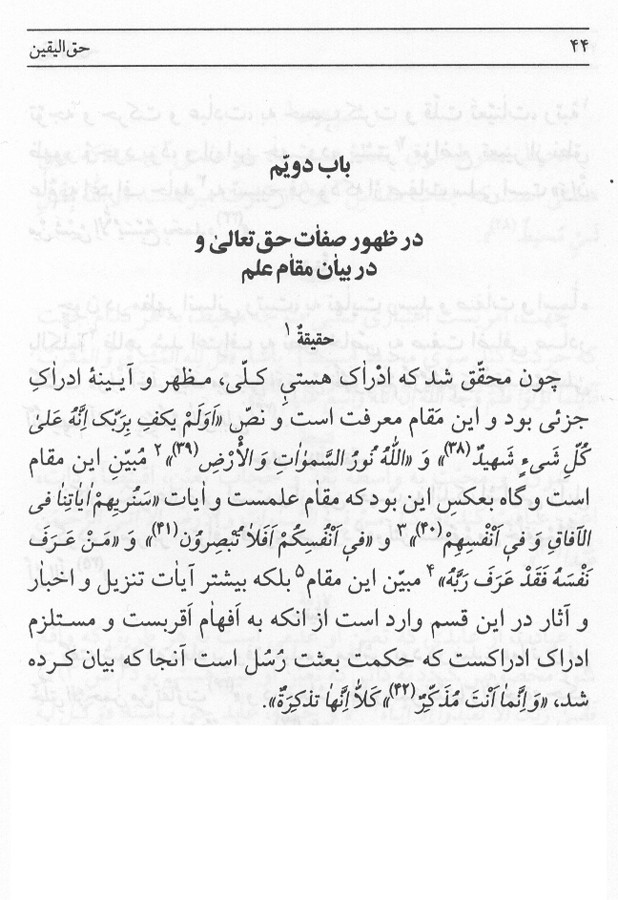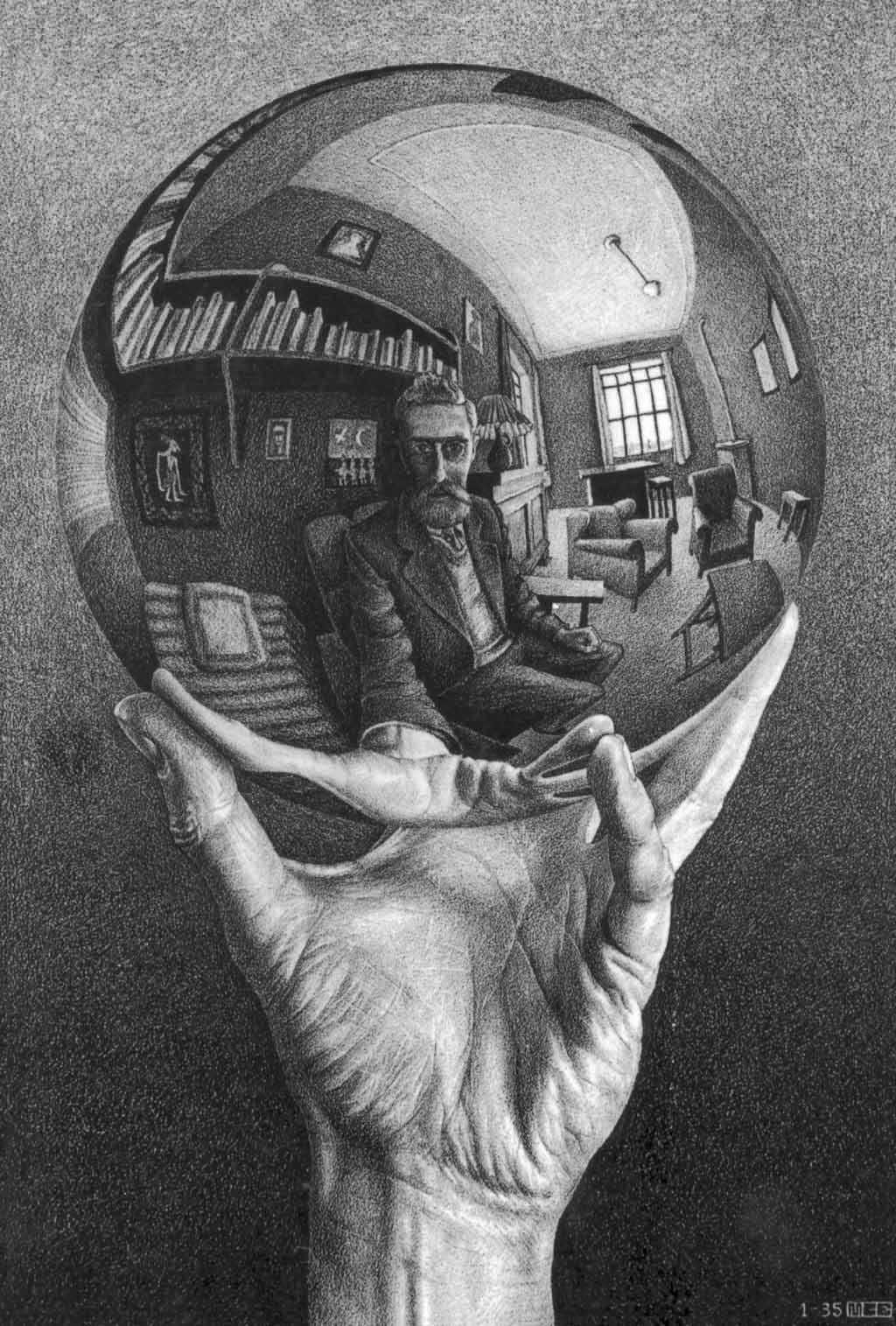The Absolute Truth & Certainty
in Cognition
of
The Lord
of the Universe
Chapter 2
On Zuhur (Emergence) of the
Divine Sifāt (Attributes)
&
The Description of the Maqām
(Station) of Knowledge
Section 1
Apercu
Discussion
Join
Reality (Haqiqa) [1]
It has been established that
the general Worldly-Idrāk (Wordly Perception & Comprehension) [1]
is the exterior and a mirror for the Segmented-Idrāk (Segmented
Perception & Comprehension) and the latter is the Maqām (Station)
for Ma’refat (Divine Gnosis). The following Divine Nass (Lections) are
the indicators as such: “Is it not
enough that your Lord does witness all things?” (Koran [41:53])
and “Allah is the Light of the
heavens and the earth” (Koran [24:35]).
And sometimes the reverse is
the Maqām (Station) for knowledge, “Soon
will We show them our Signs in the (furthest) regions (of the earth),
and in their own souls” (Koran [41:53]), “As also in your own selves: Will you not
then see?” (Koran [51:21]) and “The
person who knows his Nafs (Psyche) indeed knows his Lord” are
the indicators of this Maqām (Station) for knowledge.
Indeed majority of the Divine
Revelations, Prophetic Narrations and remnants are within this Maqām
(Station) for knowledge being close to rationalization & reasoning
of the Human-Mind-Idrāk (Human Mind's Perception & Comprehension)
i.e. the wisdom behind dispatching the Messengers was for the purpose
of (Remembering), “Therefore do
remind them, for you are the one to admonish” (Koran [88:21])
and “By no means (should it be so)!
For it is indeed a Message of instruction” (Koran [80:11]).
End.
Apercu
In this world no matter who we
are and what we do, we are facing IT! There is no way to escape IT and
if we try to escape IT we are still facing IT during the run. Therefore
between you and IT there is an exterior (for us) made up of the
knowledge & rationalization that you are facing IT perpetually. So
if you have no other understanding or knowledge you know for sure with
absolute certainty that you are facing something constantly, but you
just do not know what IT is. This
is a reality staring you in the face.
This exterior also is a mirror
reflecting what is within. If you try to dissect things up you will not
be able to get within, you will not be able to see within. When you
look inside you, all you find are tissues and cells or psychologically
just ideas and memories. So
you know as a reality and for certain there is something within you
that is ‘you’ not tissues or memories.
But the exterior reflects the
light from within since the interior was a segment from an alien
luminous realm where there is no way to reach it except by viewing
these reflections.
Therefore the exterior mirror
is able to reflect this lucent interior, both formed by different types
of knowledge & comprehension, each from a different universe.
Q: Why Sheikh Shabestari wrote
the way he did?
A: The First rule in Sufi
writings was being laconic and much attention was given to the economy
of the words. The reason was, the closer to the Divine Presence you get
due to the nature of Tawhid (Divine Oneness) less & less words are
possible. And again if you read the text carefully you find terms like
mirror or exterior or station i.e. the second rule was to use ordinary
objects to described complex spiritual matters. Point was made that
ordinary objects are closer in our mind to Haqiqa (Reality).
While these writings give an
impression of the philosophizing and even philosophical terms of the
time were used in the text, the intent of the Sheikh Shabestari was not
to write a philosophical book. I suspect the book is a vehicle to
shatter the stagnation on the path of the Morid (Seeker) who is being
told the same words again & again and needs to think different to
make progress.
Finally as you can see Sufis
of those days, some 700 years ago, read Koran differently than we do
today. The entire 30-page booklet is about how to read over 200 verses
from Koran. Therefore this book can be viewed as a Sufi training guide
on how to read Koran.
[1] Haqiqa is the awareness
& consciousness that you are subsisting & facing the Al-Haqq
(The True & Absolute Divine Reality, The Lord). Jonaid said,
“Haqiqa despises anything remaining within the heart subject to the
explanation or interpretation”. Meaning the truth of Haqiqa is a
reality e.g. gazing upon the sun or moon. It is there with no
ambiguities or misinterpretations. And like glancing upon the moon soon
your entire awareness is consumed into a reality that has no
ambiguities. Before each section Sheikh Shabestari placed a tag e.g.
Haqiqa or Natija (Inference) and so on, this was done in order to make
clear which sections are dealing with Reality from the other world and
which sections deal with human rationalization. More than often the
Morid (Seeker) mixes these up and applies what belongs to this world to
the other world and vice a versa.
[2] Idrāk means to grasp,
attainment, perception and comprehension. However if this comprehension
is exhausted and unable to comprehend something, the recognition of
that exhaustion is also Idrāk of some form. Idrāk-Idrāk in the
Shabestari terminology is translated as Human-Mind-Idrāk to be read (Human Mind's Perception &
Comprehension) .
Worldly-Idrāk (Worldly Perception & Comprehension) should be read
as “Worldly Perception & Comprehension” that means the
comprehension within this world. Segmented-Idrāk (Segmented Perception
& Comprehension) should be read as “Segmented Perception &
Comprehension” which means a segment of comprehension from a larger
collective from another universe.
© 2004-2002,
Dara O. Shayda


